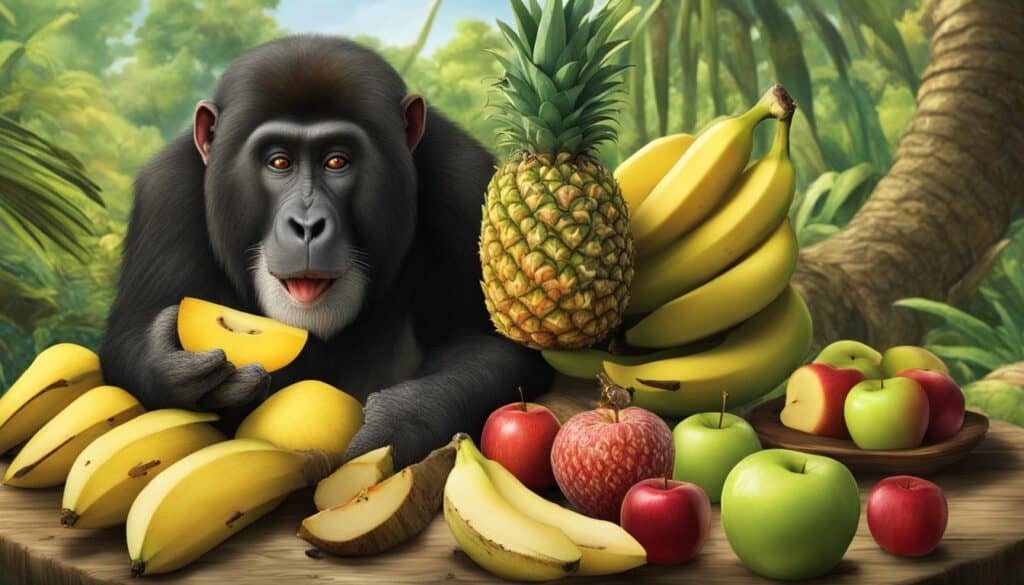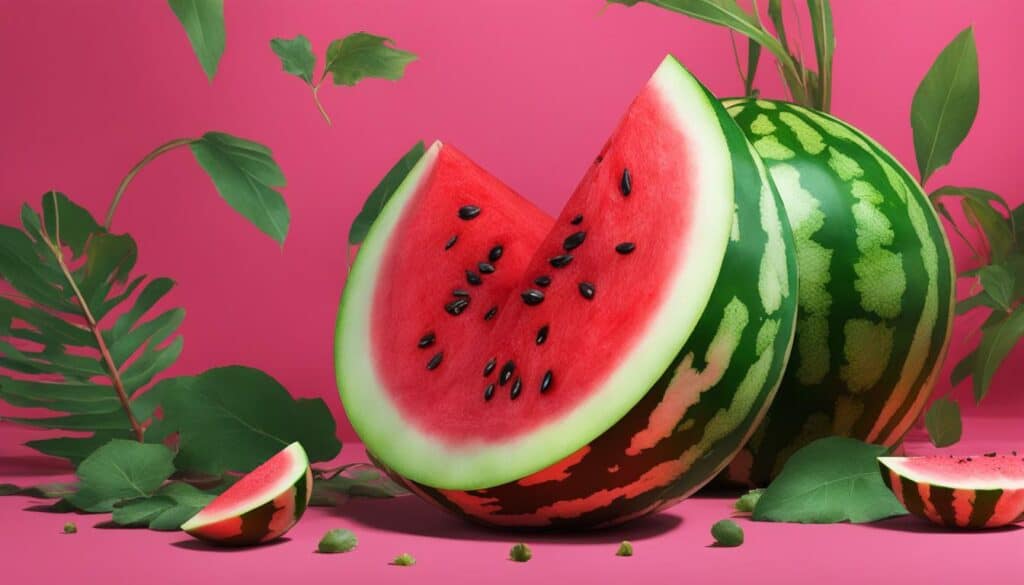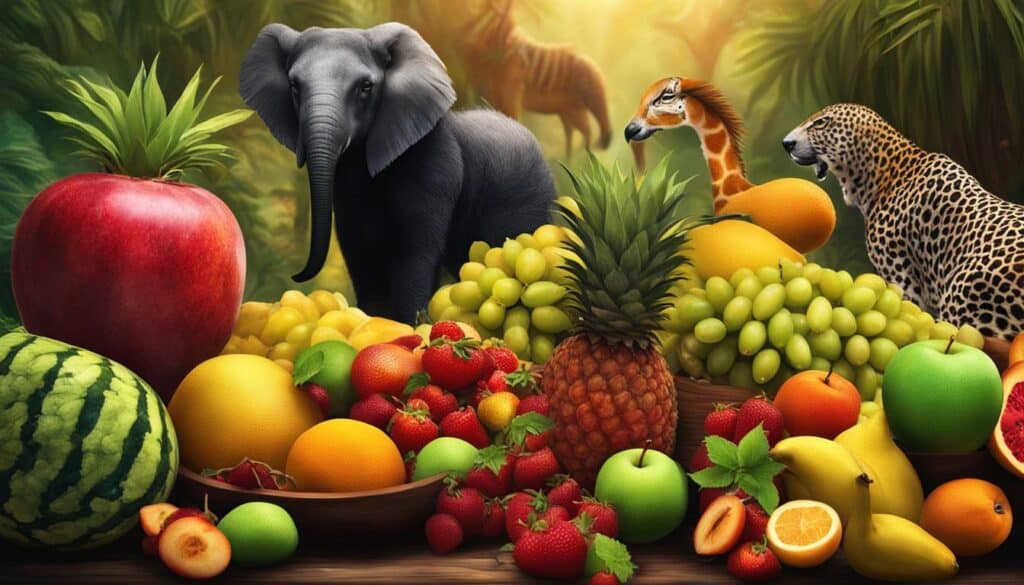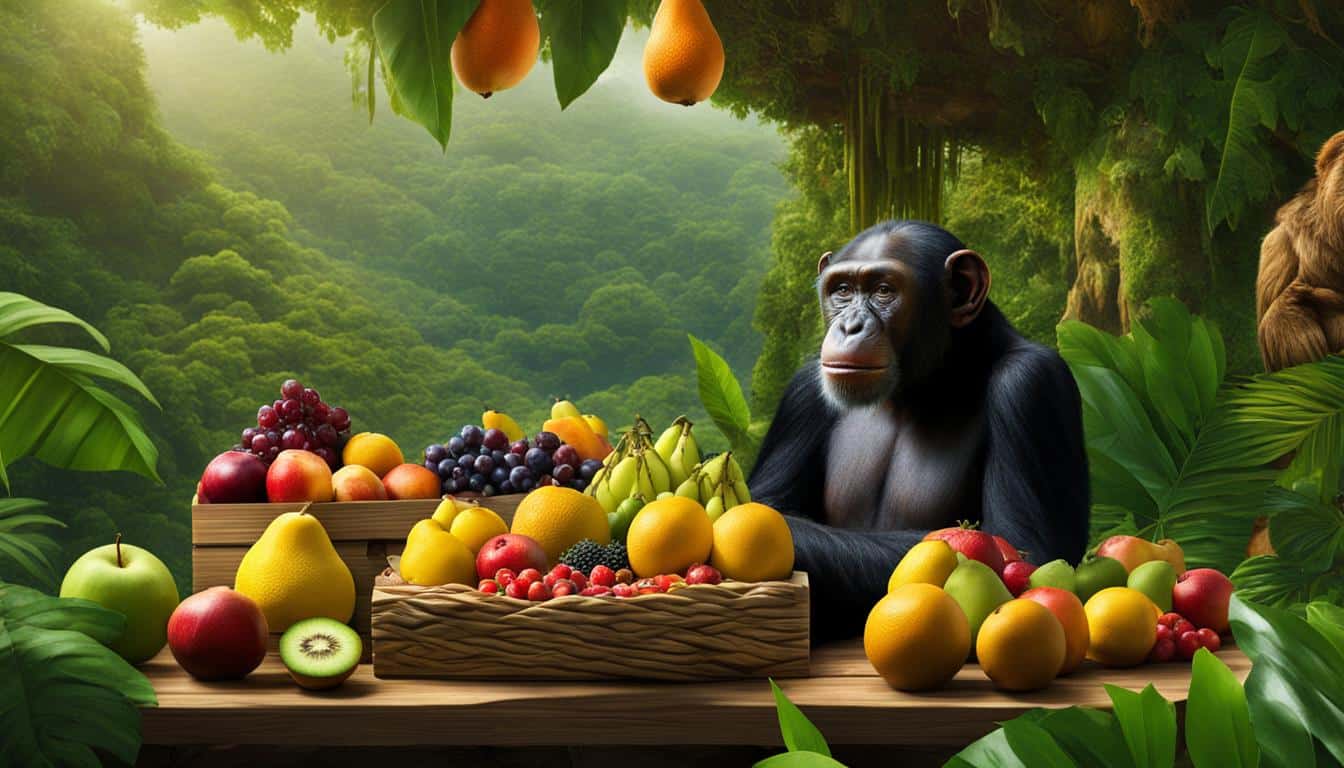Growing concerns have arisen about the impact of sweet fruit on the health of zoo animals. It turns out that cultivated fruits, specifically modified to be sweeter and larger, may not be suitable for our furry friends. This change in fruit composition can be attributed to advances in agricultural practices such as selective breeding, resulting in fruits that are significantly sweeter than their natural counterparts. So why does this matter?
High sugar content in cultivated fruits has led to weight gain and tooth decay in zoo animals. Take primates, for example. The red pandas and monkeys in particular have shown signs of these health issues due to their preference for these modified, high-sugar fruits. This imbalance in their diet, caused by the excessive sweetness of cultivated fruits, has prompted zookeepers to find healthier alternatives for the animals.
Over time, cultivated fruits have undergone genetic modifications to make them more desirable to humans. Watermelons with deeper red flesh, bananas with smaller seeds, and larger, juicier peaches are just a few examples. These changes in fruit composition have come about through the process of selective breeding and technological advancements in agriculture. However, these modifications have resulted in fruits that are significantly sweeter than their wild counterparts, posing challenges in selecting suitable fruits for the diets of zoo animals.
The sugar content of cultivated fruits has skyrocketed in recent years. In fact, reports show that the soluble sugar content of fruits like plums has almost doubled in the past two decades. Such high levels of sugar are not typical in the natural diets of zoo animals and can lead to weight gain and other health issues. Zookeepers must exercise caution when selecting fruits for the animals’ diets to avoid feeding them fruits that are too sweet and detrimental to their health.
While sweet fruits may not be suitable for zoo animals, we humans can still enjoy their health benefits. Regular fruit consumption has been associated with a reduced risk of cardiovascular disease, stroke, obesity, and various cancers. The natural sugars found in fruits are packaged with fiber, which slows down their absorption into the bloodstream. This distinguishes them from refined sugars found in candies and sodas, which can cause spikes in blood sugar levels.
Recognizing the negative impact of sweet fruits on the health of zoo animals, zookeepers have made dietary adjustments. Fruits have been replaced with nutritional pellets sweetened with pear for red pandas and monkeys. Other animals are now receiving more green, leafy vegetables as a substitute for their usual fruit intake. These changes allow the animals to maintain a diet closer to what they would have in the wild, avoiding the negative effects of excessive sugar consumption.
The impact of sweet fruits on zoo animals’ health has prompted changes in the diets of zookeepers themselves. They have realized the need to reduce their fruit intake, especially the sweeter varieties, to avoid overconsumption of sugar. Zookeepers have started incorporating more green, leafy vegetables into their diets, aligning with the dietary adjustments made for the animals in their care.
It is crucial to cater to the specific dietary needs and preferences of each animal. By understanding their natural food choices, zookeepers can ensure their overall health and well-being. With the right selection of fruits and alternative food choices, we can maintain the optimal health of our beloved zoo animals.
Key Takeaways:
- The high sugar content in cultivated fruits can lead to weight gain and tooth decay in zoo animals.
- Cultivated fruits have been modified to be sweeter and larger than their natural counterparts through selective breeding and technological advancements in agriculture.
- Zookeepers must exercise caution when selecting fruits for zoo animals to avoid feeding them fruits that are too sweet.
- Regular fruit consumption has numerous health benefits for humans, including a reduced risk of cardiovascular disease and obesity.
- Dietary adjustments for zoo animals, such as replacing sweet fruits with nutritional alternatives, can promote their overall health and well-being.
- Zookeepers have also made changes to their own diets to reduce the consumption of overly sweet fruits.
The Impact of Sweet Fruits on Zoo Animal Health
The consumption of sweet fruits by zoo animals can have significant consequences for their health. Primates, including red pandas and monkeys, are particularly inclined toward these modified, high-sugar fruits, resulting in weight gain and signs of tooth decay. These animals have developed a preference for cultivated fruits that are sweeter than their natural counterparts, leading to an imbalance in their diet.
The excessive sweetness of these fruits poses a challenge for zookeepers in ensuring the overall well-being of their animals. It is crucial to take into account the dietary restrictions of zoo animals and avoid feeding them fruits that are too sweet. While fruits are an essential part of their diet, it is necessary to strike a balance and provide healthier alternatives.
“The impact of sweet fruits on the health of zoo animals can be significant. The excessive sweetness of these fruits can result in weight gain and tooth decay. It is important for zookeepers to consider the dietary restrictions of the animals and find healthier alternatives.”
The Dietary Restrictions of Zoo Animals
Each species of zoo animal has its own unique dietary requirements and restrictions. Some animals, such as primates, have evolved to consume a diverse range of fruits in the wild. However, the fruits available in zoos may differ significantly from what these animals would typically find in their natural habitats.
Zookeepers must keep track of the sugar content in the fruits provided to the animals. High sugar fruits can lead to imbalances in their diets, causing weight gain, digestive issues, and other health problems. It is essential to provide zoo animals with fruits that closely resemble their natural diet, avoiding excessive sugar intake.
“Zoo animals have specific dietary restrictions that need to be considered when providing them with fruits. High sugar fruits can disrupt their diet and lead to various health issues. It is crucial to prioritize their well-being by offering alternatives that align with their natural preferences.”
Healthier Alternatives for Zoo Animals
Given the negative impact of sweet fruits on zoo animals’ health, zookeepers have started exploring healthier alternatives to manage their diets effectively. These alternatives aim to offer the necessary nutrients while maintaining a balance and avoiding excessive sugar intake.
One such alternative is the use of nutritional pellets fortified with pear for primates like red pandas and monkeys. These pellets provide a balanced diet without the high sugar content found in cultivated fruits. Additionally, incorporating green, leafy vegetables can provide necessary vitamins and minerals that complement zoo animals’ dietary requirements.
“Zookeepers are actively searching for alternatives to sweet fruits to maintain the health of their animals. Nutritional pellets and green vegetables provide the necessary nutrients without the excessive sugar content found in cultivated fruits.”
The Evolution of Cultivated Fruits
Over time, cultivated fruits have undergone genetic modifications that make them sweeter and more desirable to humans. Selective breeding and technological advancements in agriculture have resulted in significant changes in fruit composition. Fruits like watermelons with deeper red flesh, bananas with smaller seeds, and larger, juicier peaches are prime examples of these modifications.
However, the increase in sweetness of cultivated fruits has posed challenges in selecting suitable fruits for the diets of zoo animals. The significantly higher sugar content of these fruits compared to their wild counterparts can have adverse effects on the health and well-being of zoo animals.
“The sugar content of cultivated fruits has increased due to genetic modifications, making them less appropriate for inclusion in zoo animal diets.”
Catering to the dietary needs of zoo animals requires careful consideration of their natural habitat and food preferences. Feeding them fruits that are too sweet can lead to weight gain, tooth decay, and other health issues. Therefore, zookeepers must carefully select fruits for zoo animal diets, opting for varieties that closely resemble the fruits found in their natural habitats.
The Challenge of Fruit Selection for Zoo Animal Diets
When choosing fruits for zoo animals, it is important to strike a balance between providing nutrition and mimicking their natural diets. While cultivated fruits may be appealing and easily available, they may not always be the best choice for the animals’ health.
Consider the sugar content of popular cultivated fruits:
| Fruit | Sugar Content (per 100g) |
|---|---|
| Watermelon | 6g |
| Banana | 17g |
| Peach | 8g |
Compared to their wild counterparts, these cultivated fruits contain significantly higher sugar content. For example, wild watermelons have sugar content ranging from 1-5g per 100g, while bananas typically have a sugar content of around 3g per 100g. These differences in sugar content highlight the need for careful fruit selection to avoid providing zoo animals with fruits that are too sweet for their dietary needs.
To ensure the health and well-being of zoo animals, zookeepers should prioritize providing fruits with lower sugar content and a nutritional profile closer to what they would find in the wild. Green, leafy vegetables and fruits with a more moderate sugar content can serve as alternative options for zoo animals, allowing them to maintain a balanced diet without the excessive intake of sweet fruits.
In conclusion, the evolution of cultivated fruits has resulted in sweeter varieties that are more desirable to humans. However, these modifications have made it challenging to select suitable fruits for the diets of zoo animals. By understanding the sugar content of cultivated fruits and considering the dietary needs of zoo animals, zookeepers can make informed fruit choices that promote optimal health and well-being.
The Sugar Content of Cultivated Fruits
Cultivated fruits have undergone significant changes in their sugar content compared to their wild counterparts. In fact, reports indicate that the soluble sugar content of fruits like plums has nearly doubled in the past two decades. This increase in sweetness poses a potential risk to the health of zoo animals since their natural diets do not typically include such high levels of sugar. As a result, it’s crucial for zookeepers to exercise caution when selecting fruits for the animals’ diets, ensuring they avoid feeding them fruits that are too sweet and can lead to weight gain and other health issues.
“Cultivated fruits have significantly higher sugar content than their wild counterparts.”
The Benefits of Fruit for Humans
While sweet fruits may not be suitable for zoo animals, they offer numerous health benefits to humans. Regular fruit consumption has been associated with a reduced risk of cardiovascular disease, stroke, obesity, and various cancers. Fruits are packed with essential vitamins, minerals, and dietary fiber that contribute to overall well-being.
The natural sugars found in fruits, such as fructose, are different from refined sugars found in candies and sodas. Unlike refined sugars, the natural sugars in fruits come bundled with fiber, which slows down their absorption into the bloodstream. This slow release of sugar helps regulate blood sugar levels and prevents spikes that can lead to health issues like diabetes.
“Let food be thy medicine and medicine be thy food.” – Hippocrates
The wide variety of fruits available allows for a diverse and enjoyable eating experience. From succulent berries to refreshing citrus fruits, there is something for everyone. Incorporating a variety of fruits into your diet not only adds flavor but also supplies essential nutrients to support a healthy lifestyle.
A balanced diet that includes a generous portion of fruits promotes weight management, boosts the immune system, and improves overall digestion. Whether consumed fresh, frozen, or blended into smoothies, fruits are a delicious and nutritious addition to any meal or snack.
The Antioxidant Power of Fruits
Fruits are rich in antioxidants, which help combat the harmful effects of free radicals in the body. These compounds reduce inflammation, protect against oxidative stress, and promote cellular health. Antioxidants found in fruits, such as vitamin C, vitamin E, and flavonoids, have been linked to a reduced risk of chronic diseases like heart disease and certain types of cancer.
Incorporating Fruits Into Your Diet
To reap the benefits of fruits, aim to include a variety of them in your daily diet. Here are some tips for incorporating fruits into your meals:
- Add sliced fruits to your breakfast cereal or yogurt for a refreshing start to the day.
- Snack on whole fruits like apples, oranges, or grapes between meals.
- Blend fruits into smoothies for a quick and nutritious on-the-go snack.
- Create colorful fruit salads by combining different types of fruits.
- Use fruits as natural sweeteners in homemade desserts or baked goods.
Remember to choose fruits that are in season, as they tend to be fresher and more flavorful. Additionally, opt for organic fruits when possible to reduce exposure to harmful pesticides. By making fruits a regular part of your diet, you can enjoy their delicious taste while reaping the numerous health benefits they offer.
Dietary Adjustments for Zoo Animals
Recognizing the negative impact of sweet fruits on the health of zoo animals, keepers have made dietary adjustments to ensure their well-being. By understanding the fruit preferences of zoo animals and the sweet fruits to avoid feeding them, zookeepers have implemented changes that promote a healthier diet.
In the case of red pandas and monkeys, traditional fruits have been replaced with nutritional pellets sweetened with pear. This alternative provides the animals with the necessary nutrients while minimizing their consumption of excessively sweet fruits. By offering these specially formulated pellets, the keepers can maintain the animals’ fruit preferences while mitigating the risks associated with high sugar intake.
Additionally, other animals in the zoo are now receiving green, leafy vegetables as a substitute for their usual fruit intake. These vegetables provide essential vitamins and minerals, while also satisfying their natural cravings for fresh food. This dietary adjustment allows these animals to maintain a diet closer to what they would have in the wild, reducing the negative effects of excessive sugar consumption.
Here is an example of how zookeepers have adjusted the diets of red pandas and monkeys:

| Fruit | Original Diet | Revised Diet |
|---|---|---|
| Apple | Every day | Once a week |
| Banana | Every day | Once a week |
| Pear | Every day | Every day (in pellet form) |
| Grapes | Once a week | Once a week (in pellet form) |
This adjusted diet ensures that the red pandas and monkeys still receive the fruits they enjoy, but in controlled quantities. By incorporating nutritional pellets and leafy vegetables, zookeepers are now able to strike a balance, providing the animals with the nutrients they need while avoiding the detrimental effects of overly sweet fruits.
Changes in Zookeeper Diets
As zookeepers, we understand the importance of providing a balanced and nutritious diet for the animals under our care. The impact of sweet fruits on the health of zoo animals has not only led to dietary adjustments for them but also prompted changes in our own diets to ensure the well-being of both the animals and ourselves.
We have realized that reducing our fruit intake, especially the sweeter varieties, is crucial to avoid overconsumption of sugar. We are actively incorporating more green, leafy vegetables into our diets as a healthier alternative, aligning with the dietary adjustments made for the animals in our care.
By making these changes, we are not only setting an example for a balanced diet but also protecting our health by reducing the risks associated with excessive sugar consumption. We understand the importance of prioritizing the fruit preferences of zoo animals while considering our own health and well-being.
| Zookeeper Diet Adjustments | Benefits |
|---|---|
| Reducing fruit intake | – Avoiding overconsumption of sugar – Minimizing the risk of weight gain and dental issues |
| Incorporating more green, leafy vegetables | – Providing essential vitamins and minerals – Promoting overall health and well-being |
We believe that by making these changes in our diets, we are not only taking proactive steps towards a healthier lifestyle but also enhancing our ability to care for the animals with a greater understanding of their dietary needs. As zookeepers, it is our responsibility to ensure that we meet the fruit preferences of zoo animals while also taking care of our own health.
Quote:
“Our dietary adjustments reflect our commitment to the well-being of the animals under our care and ourselves. By reducing our fruit intake and incorporating more vegetables, we are fostering a healthier environment for everyone.” – Zoological Parkkeeper

Catering to Specific Animal Needs
Different zoo animals have varying dietary needs and preferences when it comes to fruits. Primates, such as red pandas and monkeys, have a strong affinity for sweet fruits but can face health issues from indulging in them. To cater to their needs, zookeepers have developed alternative food choices, such as panda pellets, to meet their nutritional requirements. By understanding the specific preferences and limitations of each animal, zookeepers can ensure their overall health and well-being.
Preferred Fruits for Zoo Animals
| Animal | Preferred Fruits |
|---|---|
| Red Pandas | Bamboo shoots, apples, pears, grapes |
| Monkeys | Bananas, oranges, apples, mangoes |
| Giraffes | Acacia leaves, apples, carrots, lettuce |
| Elephants | Bananas, watermelon, pineapples, papayas |
By providing a variety of fruits that align with each animal’s dietary needs, zookeepers can ensure a balanced and nutritious diet. For example, red pandas are primarily herbivores and rely on bamboo shoots as a staple food source. However, they can also enjoy a selection of fruits such as apples, pears, and grapes, which help provide essential vitamins and minerals. Similarly, monkeys thrive on a mix of bananas, oranges, apples, and mangoes, which offer a diverse range of nutrients.
Understanding the distinct dietary preferences of each animal allows zookeepers to create a stimulating and nourishing food environment. When animals have access to fruits that suit their needs, they are less likely to consume excessive amounts of sweet fruits and face associated health issues.
Furthermore, the table highlights the favored fruits for other zoo animals such as giraffes and elephants. While giraffes mainly consume acacia leaves, providing fruits like apples, carrots, and lettuce ensures they receive a variety of nutrients. Elephants, on the other hand, can enjoy bananas, watermelon, pineapples, and papayas as part of their diet. This allows for a well-rounded nutrition plan that caters to their specific dietary needs.

Ensuring that zoo animals have access to their preferred fruits is crucial for maintaining their overall health and well-being. By offering a diverse selection of fruits, zookeepers can replicate natural feeding behaviors and support the nutritional requirements of each animal.
Conclusion
The issue of fruits being too sweet for zoo animals highlights the detrimental consequences of human-driven changes in agriculture on animal diets. The modifications made to cultivated fruits, increasing their sweetness, have posed significant health risks to zoo animals, emphasizing the need for dietary adjustments. To ensure the overall health and well-being of the animals in their care, zookeepers must offer alternative food choices and reduce the consumption of overly sweet fruits.
It is crucial for zookeepers to consider the specific dietary needs and preferences of each animal when making food choices. By understanding the negative impact of excessive sugar consumption, zookeepers can select suitable fruits that align with the animals’ natural diets and avoid feeding them fruits that are too sweet. This approach helps maintain the optimal health and vitality of zoo animals.
The increasing sweetness of cultivated fruits is a side effect of advances in agriculture, such as selective breeding. While these modifications benefit human preferences for sweeter fruits, they have led to imbalances in zoo animal diets. To counteract this situation, zookeepers have made dietary adjustments, offering nutritional pellets sweetened with pear to primates and supplementing fruits with green, leafy vegetables for other animals.
By recognizing the impact of sweet fruits on the health of zoo animals, zookeepers have taken proactive steps to address this issue. Through careful consideration and adaptation of animal diets, they provide a safer and healthier environment for zoo animals. Future efforts should focus on continued research and collaboration to ensure that zoo animals receive appropriate and balanced nutrition.
FAQ
Why are fruits becoming too sweet for zoo animals?
Fruits have become too sweet for zoo animals due to genetic modifications through selective breeding, making them sweeter and larger than their natural counterparts.
What are the health issues caused by zoo animals consuming sweet fruits?
Consuming sweet fruits has led to weight gain and tooth decay in zoo animals, particularly in primates like red pandas and monkeys.
How have zookeepers addressed the issue of sweet fruits for zoo animals?
Zookeepers have developed alternative food choices, such as nutritional pellets sweetened with pear for red pandas and monkeys, to meet the animals’ nutritional requirements. Other animals are being given green, leafy vegetables as a substitute for their usual fruit intake.
How do cultivated fruits differ from their wild counterparts?
Cultivated fruits have higher sugar content than their wild counterparts due to genetic modifications, making them significantly sweeter.
Why is it important to avoid feeding zoo animals fruits that are too sweet?
Feeding zoo animals fruits that are too sweet can lead to weight gain and other health issues, as their natural diets would not include such high levels of sugar.
What are the benefits of fruit consumption for humans?
Regular fruit consumption has been associated with a reduced risk of cardiovascular disease, stroke, obesity, and various cancers.
How have zookeepers adjusted their own diets in response to the impact of sweet fruits on animal health?
Zookeepers have reduced their fruit intake, especially the sweeter varieties, and have started incorporating more green, leafy vegetables into their diets.
Do different zoo animals have different fruit preferences?
Yes, different zoo animals have varying dietary needs and preferences when it comes to fruits. Primates, such as red pandas and monkeys, have a strong affinity for sweet fruits.
How can zookeepers cater to the specific dietary needs of zoo animals?
By understanding the specific preferences and limitations of each animal, zookeepers can ensure their overall health and well-being by offering suitable fruits or alternative food choices.
What is the significance of the issue of fruits being too sweet for zoo animals?
The issue highlights the impact of human-driven changes in agriculture on animal diets and the importance of considering the specific dietary needs and preferences of zoo animals when making food choices.
Source Links
- https://weather.com/news/news/2018-10-03-fruit-so-sweet-zoo-stopped-feeding-them-to-animals
- https://www.smh.com.au/national/zoo-won-t-panda-to-taste-says-fruit-s-too-sweet-for-its-monkey-menu-20180928-p506lb.html
- https://www.lipstickalley.com/threads/australian-zoo-stops-feeding-animals-fruit-because-it-has-become-too-sugary.5370854/





Leave a Reply